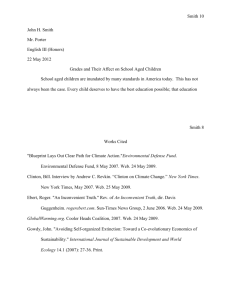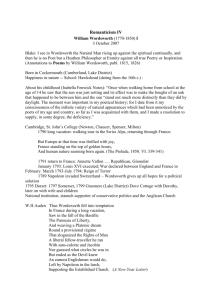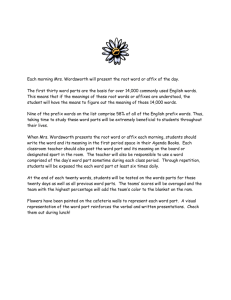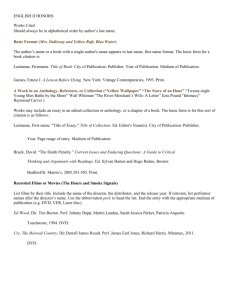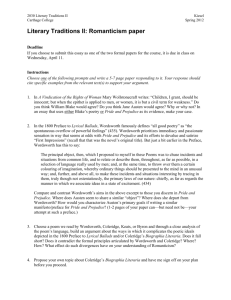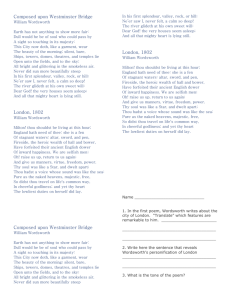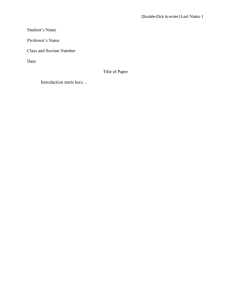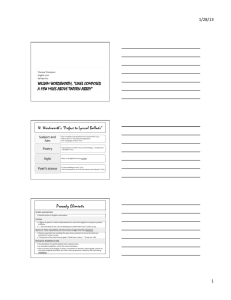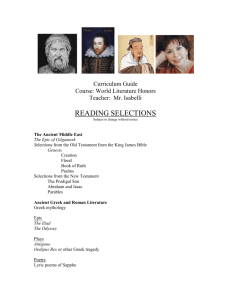(Wo)Man vs Wild - Columbus State University
advertisement
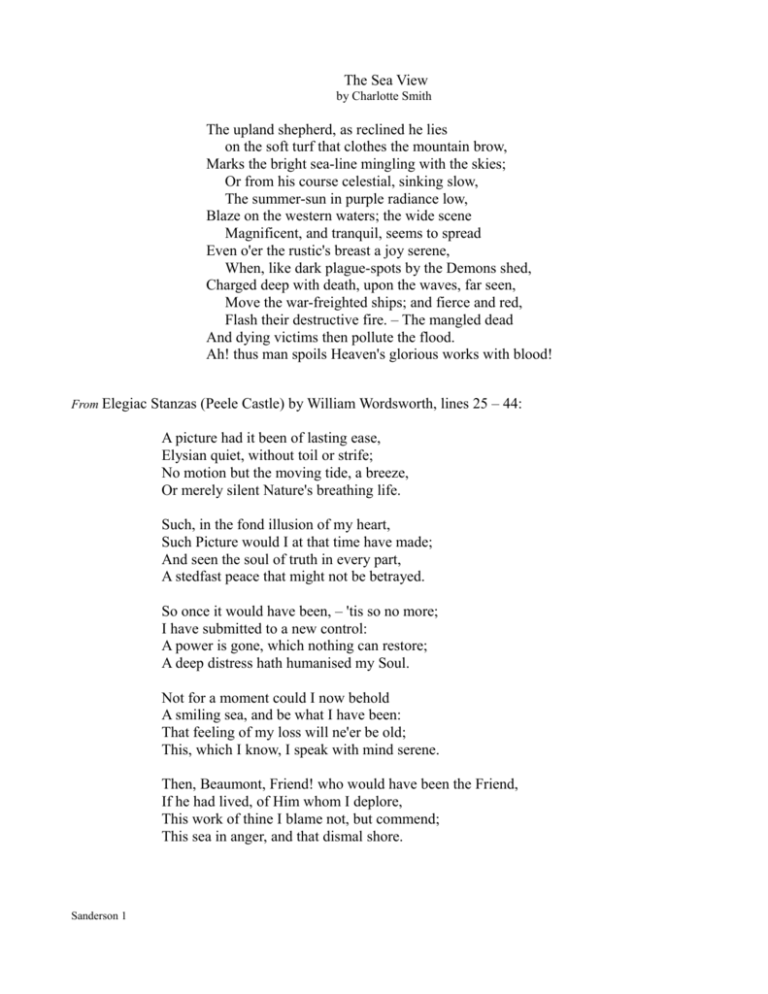
The Sea View by Charlotte Smith The upland shepherd, as reclined he lies on the soft turf that clothes the mountain brow, Marks the bright sea-line mingling with the skies; Or from his course celestial, sinking slow, The summer-sun in purple radiance low, Blaze on the western waters; the wide scene Magnificent, and tranquil, seems to spread Even o'er the rustic's breast a joy serene, When, like dark plague-spots by the Demons shed, Charged deep with death, upon the waves, far seen, Move the war-freighted ships; and fierce and red, Flash their destructive fire. – The mangled dead And dying victims then pollute the flood. Ah! thus man spoils Heaven's glorious works with blood! From Elegiac Stanzas (Peele Castle) by William Wordsworth, lines 25 – 44: A picture had it been of lasting ease, Elysian quiet, without toil or strife; No motion but the moving tide, a breeze, Or merely silent Nature's breathing life. Such, in the fond illusion of my heart, Such Picture would I at that time have made; And seen the soul of truth in every part, A stedfast peace that might not be betrayed. So once it would have been, – 'tis so no more; I have submitted to a new control: A power is gone, which nothing can restore; A deep distress hath humanised my Soul. Not for a moment could I now behold A smiling sea, and be what I have been: That feeling of my loss will ne'er be old; This, which I know, I speak with mind serene. Then, Beaumont, Friend! who would have been the Friend, If he had lived, of Him whom I deplore, This work of thine I blame not, but commend; This sea in anger, and that dismal shore. Sanderson 1 Jon Sanderson 3/16/2011 English 3138 Dr. Owen (Wo)Man vs Wild: A Comparative Analysis of The Sea View and Elegiac Stanzas Throughout the ages, the sea has characterized the duality of nature. Ocean waters are known for their calm and tranquility, for beauty of sun-kissed waves and for the endless bounty of fish. The ocean is like a mother, soft and nurturing, the beginning place of all life on our planet. And yet one cannot forget the turmoil these waters are capable of committing, wracking storms and tremendous waves to swallow man and woman alike, apathetic to the drowned that float to the ocean floor. Charlotte Smith and William Wordsworth's poems are both concerned with the beauty of nature represented in the sea, and how quickly this beauty is whisked away. Though their base topic remains the same, the two poems have contrasting viewpoints on the poet's feelings of the sea. Smith laments the tarnished waters of her “Sea View”, despoiled by the battle being held on the waters; Wordsworth sees this beauty as naivety, and points out the sea's unfeeling rage as its true form. The Sea View is rather self-explanatory in its title, and even the footnote in the Norton Anthology tells the reader that Smith was overlooking the sea during a terrible battle. She writes of a beautiful sunset, detailing the colors associated with it, “the summer-sun in purple radiance low”. She fills the reader's mind with a pretty scene before destroying it with “dark plague-spots”, the ships that begin to bombard each other. From this point, the tone of the poem shifts from awe to dismay, and the last line makes it clear that Smith is unhappy at what has happened to her beautiful ocean surface. The destruction of these ships “pollute the flood”, and it is clear that her concern lies less with the death of people and more with tainted nature. Her thesis is rather simple: Man, through bloodshed, trespasses upon nature and eventually leads to its destruction. Sanderson 2 Elegiac Stanzas does not deal with an immediate scene, but rather with Wordsworth observing a picture of Peele Castle suffering through a sea storm. He uses his typical convention of connecting thoughts of the present with feelings of the past, ala the Wordsworthian Meditation style. In this passage, Wordsworth admits his earlier thoughts of nature, “A picture had it been of lasting ease, Elysian quiet without toil or strife”, but then claims it as a “fond illusion”. Thinking of the death of his brother John, the stormy castle reminds him of the sea's apathy. The passage ends with him thanking the artist of the painting for capturing what he believes is the actuality of nature, harsh and deathly. Unlike the Wordsworth of Tintern Abbey, William sides with humanity, believing it is nature that has thrown the first stone; “a deep distress has humanised [his] soul”. Of course, their ideas of what nature actually is plays into their arguments. Wordsworth, ever the Christian mystic, uses the word 'Elysian', a word stationed in Greek mythos as the good afterlife. He refers to nature by name, capitalized, treating it as if it were a divine power of its own. Smith eschews such ideas, noting the sea as “Heaven's glorious works”, the works of God and the ships as “Demons”. Charlotte Smith attributes nature to the Christian God, presenting the ever-present duality of God and the Devil (who is representing in warring humanity), while nature stands on its own for Wordsworth. However, it is interesting to note one of Wordsworth's lines, which seem to point out a possible change of heart for him; “I have submitted to a new control” he writes, and one must wonder if his new outlook on nature of nature has led him to similar religious viewpoints, ones like Charlotte Smith. The arcs of poetic conflict in the two poems are also worthy of note. The poems do, at least, begin with the sea in the same state. The words Smith use to describe her ocean's initial state are “tranquil”, “magnificent”, a “joy serene” to see. Likewise, Wordsworth thinks back to what his younger mind would have painted it, and says that his sea is “quiet, without toil or strife”, “silent Nature's breathing life”, a picture that would have given him “lasting ease”. The tone changes with his famous Sanderson 3 line: “A steadfast peace that might not be betrayed.” This is where the arc of the two poems separate, not only in argument, but also in how it is presented. Smith's poem is a scene outside of herself, one she witnesses with her own eyes. The conflict is the warring ships that spoil her view from the overlook. Wordsworth's meditation exists in his own mind, involving less of a scene and more of his own conclusions and feelings on the nature that has “betrayed” him. His conflict is internal, and the poem decrees his change of mindset that was instigated by his brother's death. Through these observations, one last point can be made; in respect to the poets, The Sea View is static, and Elegiac Stanzas is dynamic. Smith does not waver in her opinion of nature – it is a thing of beauty and peace, a creation of God, and man's intentions pollute its magnificence, becoming like the servants of God's opposite. In Wordsworth's poem, one sees his views unfold. He tells of his old love for nature, and one sees glimpses of the Wordsworth who traveled the English countryside in awe of the rolling green hills. But now, Wordsworth cannot “behold/a smiling sea”. He determines that this painting captures nature in its most raw form, “this sea in anger, and that dismal shore”, and dares not give it the tranquility of his youth. “A power is gone, which nothing can restore”, he notes with resignation. Wordsworth has, at last, lost his innocence, and unlike Smith, who curls her lip at the “mangled dead / and dying victims”, Wordsworth feels his own life polluted by the uncaring flood, those waves that took John from him forever. Sanderson 4
